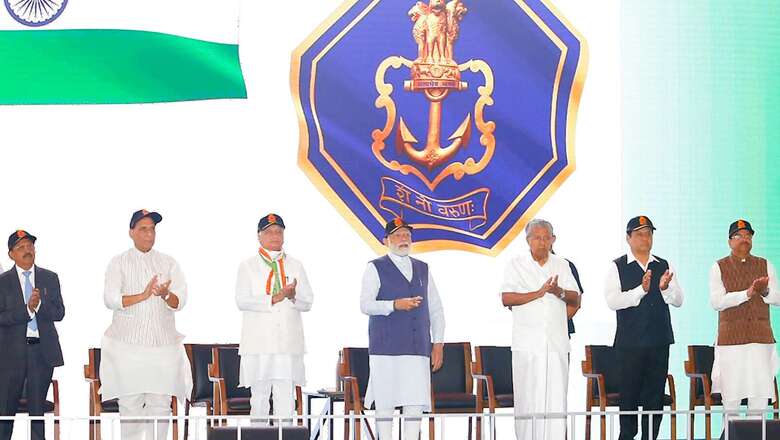
views
Indian Navy on Friday got a new ensign, shedding a trace of its colonial past on the representational flag of the force and drawing from the legacy of Chhatrapati Shivaji Maharaj. An ensign is essentially a flag bearing a particular design that is carried by vessels or formation of a naval force, indicating its identity and denotes nationality, especially in the high seas.
The new ensign has dropped the horizontal and vertical red stripes that symbolised the Cross of Saint George. An octagonal shape with twin golden borders in its fly area that draws inspiration from the seal of the Maratha ruler has been incorporated. The blue octagonal shape encompasses the National Emblem sitting atop an anchor depicting steadfastness. It is superimposed on a shield with the Navy’s motto “Sam no Varunah", meaning: ‘Be auspicious unto us Oh Varuna’.
The Lokamudra, the octagon of the royal seal, signifies the concept of welfare state as propounded by Shivaji. It was issued by the Maratha ruler in 1646.
“Marathas were a great part of our maritime past. Chhatrapati Shivaji Maharaj gave an institutional thrust to the Navy. And the Maratha navy heroically resisted colonial past. Recognition to this aspect of our maritime history is welcome," Commodore Srikant Kesnur (retd) told News18.
The use of the Maratha king’s iconography also carried immense political weight.
“For almost two to three centuries after Goa’s Kadamb navy was destroyed, no other ruler thought of a strong navy. That was the significance of Chhatrapati Shivaji Maharaj. In 1657, he took over Kalyan, Bhiwandi, Pen. And within a span of 20 years, he built a navy to be reckoned with," Dr Kedar Phalke, a historian who specialises in Shivaji Maharaj’s era, told News18.
Phalke said the importance of Shivaji Maharaj’s royal seal was also the use of Sanskrit. “Before that, the rulers’ seals were in Persian. He brought out his royal seal in Sanskrit. When we speak of nationalism today, this is an important step."
“When Maharaj started building a navy, there was no profound knowledge of ship-building. So he hired two Portuguese for their expertise. And within a span of a few years, he developed a strong navy," Phalke further said.
Asked about the significance of the move, Phalke said: “With respect to military power, Shivaji Maharaj realised that a strong navy was important for protection of swarajya from the foreigners. He had identified Portuguese, English and Dutch as the primary enemies of swarajya. They had built factories on prime locations along the coast, and Maharaj decimated that threat. He had realised that it was this naval prowess that had helped the foreigners interfere in national politics."
The historian said the importance of the move also lies in the fact that Shivaji Maharaj’s vision led to a flourishing maritime trade on the east and west coasts.
“He wanted to stop the slave trade conducted by the Janjira Siddhis. They came all the way from Africa and sent slaves to the Arab countries. Beyond this, Maharaj’s vision led to a brilliant chance of new finance. Maratha ships started merchant relations with Arabs. It opened doors of the western coast for international mercantile relations. While many important western coast ports were under the Marathas, they also started looking at eastern ports. This led to more trade with Malacca strait. Pondicherry was also under Maratha control then," Phalke said.
Read all the Latest News India and Breaking News here




















Comments
0 comment